2.1. INTRODUCTION
The “poly” in “polynomial” means “many”. Technically, the term “polynomial” should only refer to sums of many terms, but the term is used to refer to anything from one term to a zillion terms. However, the shorter polynomials do have their own names:
A one–term polynomial, such as 2x or 4x2, may also be called a “monomial”
A two–term polynomial, such as 2x + y or x2 – 4, may also be called a “binomial”
A three–term polynomial, such as 2x + y + z or x4 + 4x2 – 4, may also be called a “trinomial”
By now, you should be familiar with variables and exponents. You may have dealt with expressions like 3x4 or 6x. Polynomials are sums of these expressions. Each piece of the polynomial, each part that is being added, is called a “term”. Polynomial terms have variables to whole–number exponents; there are no square roots of exponents, no fractional powers, and no variables in the denominator. Here are some examples:
|
6x –2 |
NOT a polynomial term |
This has a negative exponent. |
|
1/x2 |
NOT a polynomial term |
This has the variable in the denominator. |
|
sqrt(x) |
NOT a polynomial term |
This has the variable inside a radical. |
|
4x2 |
a polynomial term |
|
Here is a typical polynomial: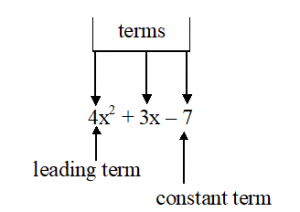
Notice the exponents on the terms. The first term has exponent 2; the second term has an understood exponent 1; and the last term doesn’t have any variable at all. Polynomials are usually written this way, with the terms written in “decreasing” order; that is, with the highest exponent first, the next highest next, and so forth, until you get down to the plain old number.
Any term that doesn’t have a variable in it is called a “constant” term because, no matter what value you may put in for the variable x, that constant term will never change. In the picture above, no matter what x might be, 7 will always be just 7.
Polynomial
A function p(x) of the form
p(x) = a0 + a1x + a2x2 + a3x3 + . . . + anxn + . . . is called a polynomial,
where
(i) a0, a1, a2 . . . an are real numbers and they are called coefficients of the polynomial.
(ii) and an is nonnegative integer.
For example
(i) 2x2 + 3x + 8 is a quadratic polynomial
(ii) is not a polynomial since the power of x is – 2.
Degree of Polynomial
The highest exponent in various terms of one variable in a polynomial is called its degree. For example The degree of x2 + 4x + 10 is 2.
Polynomials are also sometimes named for their degree:
- A second–degree polynomial, such as 4x2, x2 – 9, or ax2 + bx + c, is also called a “quadratic”
- A third-degree polynomial, such as –6x3 or x3 – 27, is also called a “cubic”
- A fourth-degree polynomial, such as x4 or 2x4 – 3x2 + 9, is sometimes called a “quartic”
- A fifth-degree polynomial, such as 2x5 or x5 – 4x3 – x + 7, is sometimes called a “quintic”
Zero of a polynomial
A real number K is said to be a Zero of a polynomial p(x), if p(K) = 0,
Example :(i) Let p(x) = x2 – 4x + 4
If p(x) at x = 2, then
P(2) = (2)2 – 4(2) + 4= 4 – 8 + 4 = 8 – 8 = 0
Hence, we can say that K = 2 is a zero of polynomial p(x).
(ii) Let p(x) = 4x3 – 3x2 – 6x + 32
If p(x) at x = –2, then
P(–2) = 4(–2)3 – 3(–2)2 – 6(–2) + 32
= –32 – 12 + 12 + 32 = –44 + 44 = 0
Hence, we can say that K = –2 is a zero of polynomial p(x).
Now, we have already studied in the previous class, how to find the zeroes of a linear polynomial,
Example: If K is a zero of p(x) = 3x + 5, then p(K) = 0
3K + 5 = 0 K =
Generally, if K is a zero of p(x) = ax + b
then p(k) = ak + b = 0
Hence, the zero of the linear polynomial ax + b is .
2.2. GEOMETRICAL MEANING OF THE ZEROES OF A POLYNOMIAL
We know that a real number K is a zero of the polynomial p(x) if p(K) = 0. If a linear polynomial ax + b, a0, then graph of y = ax + b is a straight line,
Example:
(i) The graph of y = 2x + 5 is a straight line passing through the points (1, 7) and (–1, 3).
|
x |
1 |
-1 |
|
y |
7 |
3 |

From figure–1, we can see that the graph of y = 2x + 5 intersects the x-axis midway between –2 and –3, i.e., at the point .
(ii) Consider the quadratic polynomial x2 – 4x + 3. The graph of x2 – 4x + 3 intersects the x–axis at the point (1, 0) and (3, 0). Zeroes of the polynomial x2 – 4x + 3 are the x–coordinates of the points of intersections of the graph with x–axis
|
X |
1 |
2 |
3 |
4 |
5 |
|
y = x2 – 4x + 3 |
0 |
– 1 |
0 |
3 |
8 |
|
Points |
A |
B |
C |
D |
E |
The shape of graph of the quadratic polynomial is and the curve is known as Upward parabola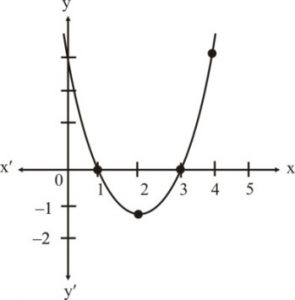
We also know that the zero of 2x + 5 is –5/2. So, the zero of the polynomial 2x + 5 is x–coordinate of the point where the graph of y = 2x + 5 intersects the x–axis.
But generally, for a linear polynomial ax + b, a 0, the graph of y = ax + b is a straight line that intersects the x-axis at exactly one point, namely, (–b/a, 0). Hence, the linear polynomial ax + b, a0 , has exactly one zero, namely, the x–coordinate of the point where the graph of y = ax + b intersects the x–axis.
Let us see for the geometrical meaning of a zero of a quadratic polynomial. Now, consider the quadratic polynomial x2 – 2x – 8 and also see the graph of y = x2 – 2x – 8. We get the following table after substituting a few values for x.

If we plot the points (–4, 16), (–3, 7), (–2, 0), (–1, –5), (0, –8), (1, –9), (2, –8), (3, –5), (4, 0), (5, 7) and (6, 16), then we get a curve. It is called a parabola. The lowest point P which is a minimum point of the curve is also called vertex of the parabola.
And the vertical line passing through P is called the axis of the parabola. Parabola is symmetric about x–axis and also called the line of symmetry.
The zero of the linear polynomial ax + b is undefined .
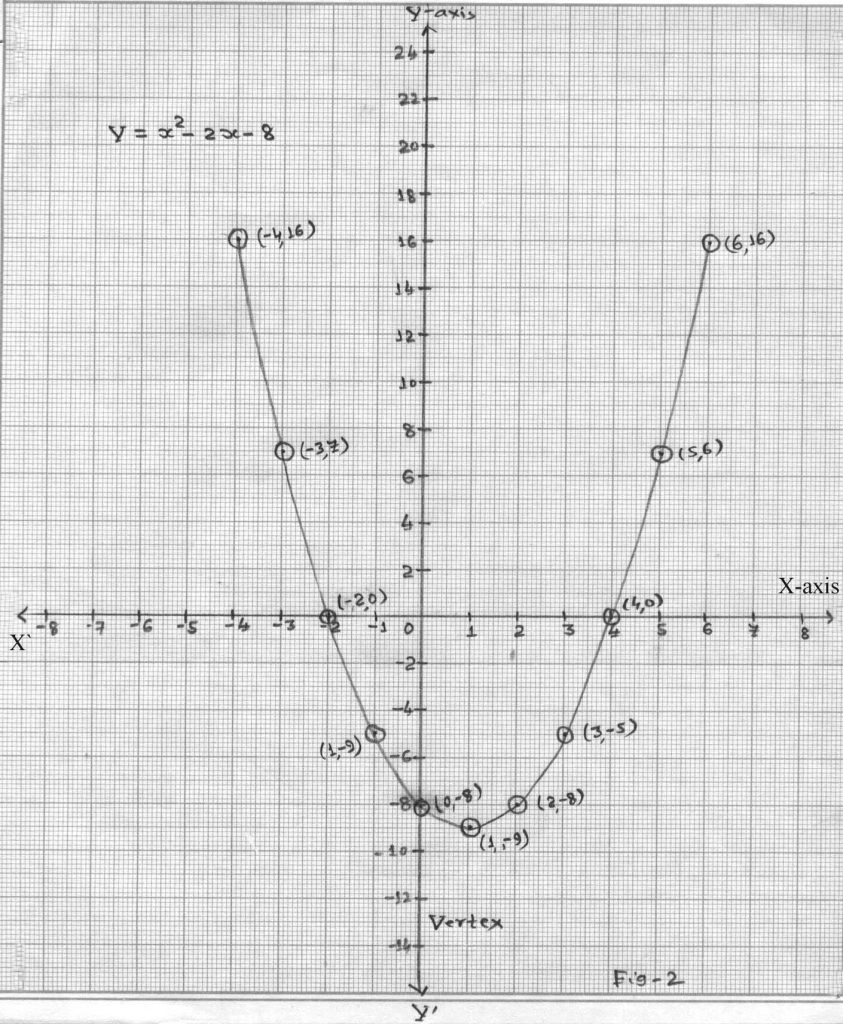
In fact, for any quadratic polynomial ax2 + bx + c = 0, ,the graph of the corresponding equation y = ax2 + bx + c has one of the two shapes either open upwards like  or open downwards
or open downwards  depending on whether a > 0 or a < 0. (such types of curves are called parabolas).
depending on whether a > 0 or a < 0. (such types of curves are called parabolas).
It is true for any quadratic polynomial, i.e., the zeroes of a quadratic polynomial ax2 + bx + c = 0, a0, are precisely the x–coordinates of the points where the parabola representing
y = ax2 + bx + c intersects the x–axis.
So, from our observation earlier about the shape of the graph of
y = ax2 + bx + c, the following three cases can be possible :
Case – I : The graph cuts x–axis at two distinct points P and P’. The x–coordinates of P and P’ are the two zeroes of the quadratic polynomial ax2 + bx + c in figure. 3 (i & ii):
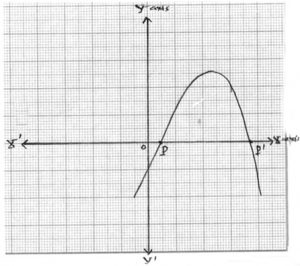

Case – II : The graph cuts the x–axis at exactly one point, i.e., at two coincident points. Hence the two points p and P¢ of Case – I coincide here to become one point P in Figure – 4 (i & ii).
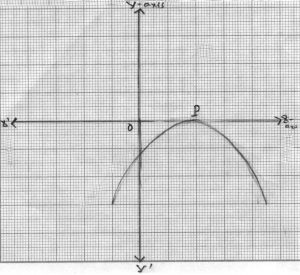
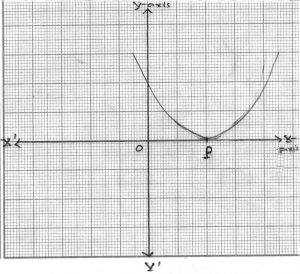
In this case the x–coordinate of P is the only zero for the quadratic polynomial ax2 + bx + c.
Case – III : The graph is either completely above x–axis or completely below the x–axis.
Hence, it does not cut the x–axis at any point. Fig. – 5 (i & ii)
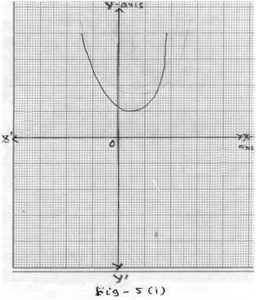
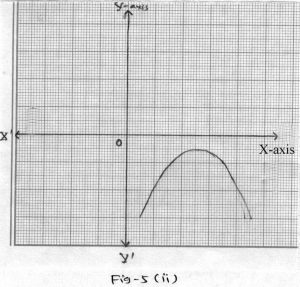
Hence, the quadratic polynomial ax2 + bx + c has no zero in this case.
Example 1:
Let us consider the cubic polynomial x3 – 4x in order to find graph of y = x3 – 4x.
Now, the values of y for various values of x are listed in the following table.
|
X |
–3 |
–2 |
–1 |
0 |
1 |
2 |
3 |
|
y = x3 – 4x |
–15 |
0 |
3 |
0 |
–3 |
0 |
15 |
Hence, the curve y = x3 – 4x passes through (–3, –15), (–2, 0), (–1, 3), (0, 0), (1, –3), (2, 0) and (3, 5) etc.
We obtain the graph of the given polynomial as fig. – 6 by plotting these points on a graph paper and drawing a free hand smooth curve.
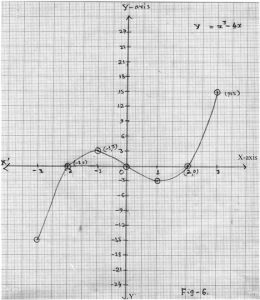
Example 2 :
Let us consider the cubic polynomial x3 –2x2 in order to find graph y = x3 – 2x2
Now, the values of y for various values of x are listed in the following table.
|
X |
–2 |
–1 |
0 |
1 |
2 |
3 |
|
Y = x3 – 2x2 |
–16 |
–3 |
0 |
–1 |
0 |
9 |
Hence, the curve y = x3 – 2x2 passes through (–2, –16), (–1, –3), (0, 0), (1, –1), (2, 0) and (3, 9) etc.
We obtain the graph of the given polynomial as fig. – 7 by plotting these points on a graph paper and drawing a free hand smooth curve.
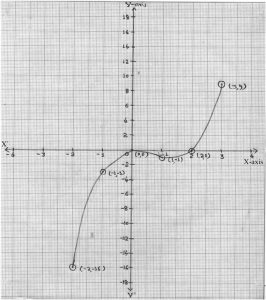
Example 3:
Let us consider the cubic polynomial x3 i.e. y=f(x)y=, .
Now, the values of y for various values of x are given in the following table :
|
X |
–2 |
–1 |
0 |
1 |
2 |
|
Y = x3 |
–8 |
–1 |
0 |
1 |
8 |
Hence, the curve y = x3 passes through (–2, 8), (–1, –1), (0, 0), (1, 1) and (2, 8) etc.
We obtain the graph of the given polynomial as fig. – 8 by plotting these points on a graph paper and drawing a free hand smooth curve.
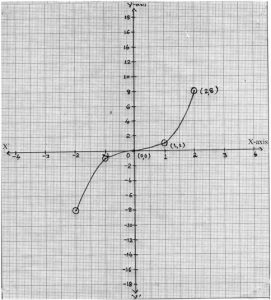
2.3. RELATIONSHIP BETWEEN ZEROES AND COEFFICIENTS OF POLYNOMIAL
We have already learnt about the factorization of quadratic polynomial by splitting the middle term.
Let p(x) = 2x2 – 16x + 30
= 2x2 – 10x – 6x + 30
= 2x(x – 5) – 6(x – 5)
= (x – 5) (2x – 6)
= 2(x – 3) (x – 5)
Now, the value of p(x) = 2x2 – 16x + 30 is zero when (x – 3) = 0 or (x – 5) = 0 i.e., when x = 3 or x = 5.
The zeroes of 2x2 – 16x + 30 are 3 and 5.
Hence, sum of its zeroes is 3 + 5 = 8
.
And product of its zeroes is
Generally, Let and be the zeroes of the quadratic polynomial p(x) = ax2 + bx + c, a0, then we know that and are the factors of p(x).
Hence, ax2 + bx + c = K(x-)(x-) ; Where K = a constant.
= K
=
Now, comparing the coefficients of x2, x and constant terms on both sides, we get a = K, b = and c=K
i.e., Sum of the zeroes is
The product of zeroes is
Points To Remember
A quadratic polynomial whose zeroes are and is given by
Generally, let and be the zeroes of the cubic polynomial ax3 + bx2+ cx + d, then
(i)
(ii)
(iii)
(iv)
Example 4
Find a quadratic polynomial, the sum and the product of whose zeroes are –5 and 3 respectively.
Solution
Let the quadratic polynomial be ax2 + bx + c, and the zeroes be and .
Then, we have
and
If a = 1, then b = 5 and c = 3.
Hence, the quadratic polynomial which fits the given conditions is x2 + 5x + 3.
Example 5
Verify that , 1, –2 are the zeroes of the cubic polynomial
p(x) = 2x3 + x2 – 5x + 2, and then verify the relation between the zeroes and the coefficients.
Solution
Comparing the given polynomial with ax3 + bx2 + cx + d, we get
a = 2, b = 1, c = –5 and d = 2
p(1) = 2(1)3 + (1)2 – 5(1) + 2 = 2 + 1 – 5 + 2
= 5 – 5 = 0
p(–2) = 2 (–2)3 + (–2)2 – 5 (–2) + 2
= –16 + 4 + 10 + 2
= –16 + 16 = 0
Thus, , 1 and –2 are the zeroes of 2x3 + x2 – 5 x + 2.
Hence, we take Now,
2.4. REMAINDER THEOREM AND FACTOR THEOREM REMAINDER THEOREM
Statement : If p(x) is any polynomial of degree greater than or equal to 1 and let a be any real number. If p(x) is divided by the linear polynomial x – a, then the remainder is p(a).
Proof :
Let q(x) be the quotient and R be the remainder obtained when f(x) is divided by (x – a).
We know that Dividend = Divisor × Quotient + Remainder
f(x) = (x – a) × q(x) + R
Put x = a, then f(a) = (a – a) × q(a) + R
f(a) = 0 + R = R= R
The above concept is known as Remainder Theorem
Example:
f(x) = x3 – 6x2 + 12x – 8 is divided by x + 2
Remainder = f(a) = f(–2)
= (– 2)3 – 6(– 2)2 +12(– 2) – 8
= – 8 – 24 – 24 – 8 = – 64
Remainder = – 64
Factor Theorem
Statement :
Let f(x) be a polynomial of degree n > 0. If f(a) = 0 for a real number a, then (x – a) is a factor of f(x).
Conversely, if (x – a) is a factor of f (x), then f(a) = 0.
Proof : Let f(x) be polynomial of degree n > 0.
If f(a) = 0 for a real number a, then (x – a) is a factor of f(x).
Conversely, if (x – a) is a factor of f(x), then f(a) = 0
According to division algorithm
Dividend = divisor × quotient + remainder
f(x) = q (x) × (x – a) + R
We know f(a) = R
According to remainder theorem,
If f (a) = 0 = R i.e., remainder is zero then f(x) = q(x) (x – a)
Hence (x – a) is the factor.
This above theorem is known as Factor Theorem
Example: f (x) = 3x2 – 7x + 4 & (x – 1) divides f (x)
a = 1
Remainder = f (a) = f (1)
= 3(1)2 – 7(1) + 4 = 3 – 7 + 4 = 0
(x – 1) is a factor of f(x) = 3x2 – 7x + 4
Important Points
1) If (x – a) divides f(x), then remainder = f(a)
(value of x is found by equating the divisor to zero x – a = 0).
2) If for any polynomial f(x), if f(0) = 0 then x is a factor of f(x) and if f(a) = 0 then
(x – a) is a factor of f(x).
3) Degree of any polynomial must always be equal to the degree of the product of its factors.
Useful factors
1) x2 – y2 = (x –y) (x + y)
2) x3 – y3 = (x – y) (x2 + xy + y2)
3) x4 – y4 = (x – y) (x3 + x2 y + xy2 + y3)
4) x5 – y5 = (x – y) (x4 + x3 y + x2 yi xy3 + y4)
5) xn – yn = (x – y) (xn–1 + xn–2 y + xn–3 y2 + xn–4 y3 + . . . + xyn–2 + yn–1 )
2.5. LIMITATIONS OF REMAINDER THEOREM
Let us find the remainder when x2009 is divided by x2 – 1. Here, Dividend = x2009 = f(x) (say)
Divisor = x2 – 1
In order to find the remainder we have to find the zero of the division and then apply the remainder theorem.
Zero of the divisor, x2 – 1 is given by, x2 – 1 = 0
x2 = 1
x = ±1
Now, f(1) = (1)2005 = 1 and f (–1) = (–1)2005 = –1
From above we observe that we have obtained two remainders i.e., 1 & –1
Which is a CONTRADICTION as we get only one remainder.
Thus, the remainder theorem fails when the degree of the divisor is greater than 1.
2.6. DIVISION ALGORITHM FOR POLYNOMIALS
We know that a cubic polynomial has at most three zeroes. If we have given only one zero then we have to find other two. Let us consider the cubic polynomial x3 + 4x2 –x– 4. If one of its zeroes is 1, then we know that x – 1 is a factor of x3 + 4x2 – x – 4. Now, we can divide x3 + 4x2 – x – 4 by x – 1 and we will get (as previous class) the quotient x3 + 3x – 4.
Again, we can get the factor of x2 + 3x – 4, by splitting the middle term, as (x + 1) (x + 4)
Hence, x3 + 4x2 – x – 4 = (x – 1) (x + 1) (x + 4)
i.e., all the three zeroes of the cubic polynomial are known to us as 1, –1, –4
Dividend = Divisor Quotient + Remainder
Example 6
Divide : 5x3 – 13x2 + 21x – 14 by x2 – 2x + 3 and verify division algorithm.
Solution :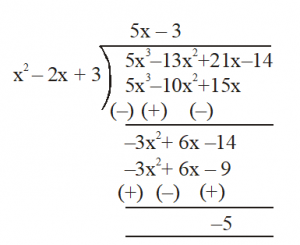
Now, Quotient = 5x – 3
Remainder = –5. We know that
Dividend = Divisor Quotient + Remainder
= (x2 – 2x + 3) (5x – 3) + (–5)
= 5x3 – 10x2 + 15x – 3x2 + 6x – 9 – 5
= 5x3 – 13x2 + 21x – 14
Hence, the division algorithm is verified.
Example 7
Find all the zeroes of 2x4 – 3x3 – 3x2 + 6x – 2, if we know that two of its zeroes are and .
Solution :
We know that, if x = is a zero of a polynomial, then x is a factor of f(x).
Since and are zeroes of f(x).
is a factor of f(x).
Now, we divide f(x) = 2x4 – 3x3 – 3x2 + 6x – 2 by g(x) = x2 – 2 to find the other zeroes of f(x).
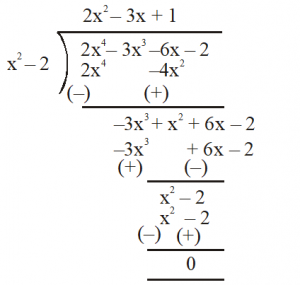
By division algorithm, we have
2x4 – 3x3 – 3x2 + 6x – 2 = (x2 – 2) (2x2 – 3x + 1)
Hence, the zeroes of the given polynomial are and 1/2.








